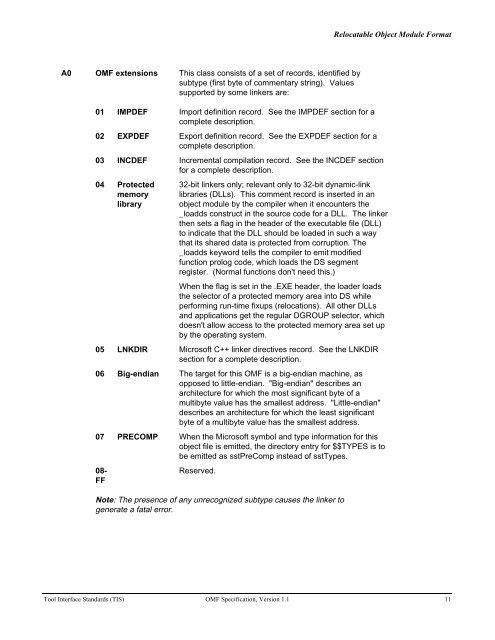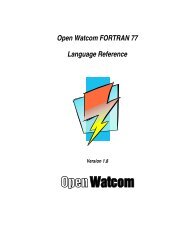Relocatable Object Module Format (OMF) Specification
Relocatable Object Module Format (OMF) Specification
Relocatable Object Module Format (OMF) Specification
Create successful ePaper yourself
Turn your PDF publications into a flip-book with our unique Google optimized e-Paper software.
<strong>Relocatable</strong> <strong>Object</strong> <strong>Module</strong> <strong>Format</strong><br />
A0 <strong>OMF</strong> extensions This class consists of a set of records, identified by<br />
subtype (first byte of commentary string). Values<br />
supported by some linkers are:<br />
01 IMPDEF Import definition record. See the IMPDEF section for a<br />
complete description.<br />
02 EXPDEF Export definition record. See the EXPDEF section for a<br />
complete description.<br />
03 INCDEF Incremental compilation record. See the INCDEF section<br />
for a complete description.<br />
04 Protected<br />
memory<br />
library<br />
32-bit linkers only; relevant only to 32-bit dynamic-link<br />
libraries (DLLs). This comment record is inserted in an<br />
object module by the compiler when it encounters the<br />
_loadds construct in the source code for a DLL. The linker<br />
then sets a flag in the header of the executable file (DLL)<br />
to indicate that the DLL should be loaded in such a way<br />
that its shared data is protected from corruption. The<br />
_loadds keyword tells the compiler to emit modified<br />
function prolog code, which loads the DS segment<br />
register. (Normal functions don't need this.)<br />
When the flag is set in the .EXE header, the loader loads<br />
the selector of a protected memory area into DS while<br />
performing run-time fixups (relocations). All other DLLs<br />
and applications get the regular DGROUP selector, which<br />
doesn't allow access to the protected memory area set up<br />
by the operating system.<br />
05 LNKDIR Microsoft C++ linker directives record. See the LNKDIR<br />
section for a complete description.<br />
06 Big-endian The target for this <strong>OMF</strong> is a big-endian machine, as<br />
opposed to little-endian. "Big-endian" describes an<br />
architecture for which the most significant byte of a<br />
multibyte value has the smallest address. "Little-endian"<br />
describes an architecture for which the least significant<br />
byte of a multibyte value has the smallest address.<br />
07 PRECOMP When the Microsoft symbol and type information for this<br />
object file is emitted, the directory entry for $$TYPES is to<br />
be emitted as sstPreComp instead of sstTypes.<br />
08-<br />
FF<br />
Reserved.<br />
Note: The presence of any unrecognized subtype causes the linker to<br />
generate a fatal error.<br />
Tool Interface Standards (TIS) <strong>OMF</strong> <strong>Specification</strong>, Version 1.1 11
















